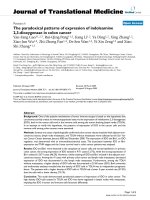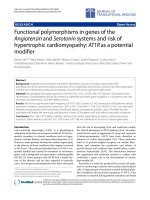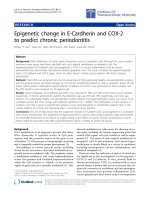Báo cáo hóa học: " The “Excellence in Translational Medicine” and “Bedside-to-Bench” Awards 2008-09" pptx
Bạn đang xem bản rút gọn của tài liệu. Xem và tải ngay bản đầy đủ của tài liệu tại đây (177.52 KB, 2 trang )
EDI T O R I A L Open Access
The “Excellence in Translational Medicine ” and
“Bedside-to-Bench” Awards 2008-09
Richard J Ablin
1*
, Francesco M Marincola
2
, Pier Giorgio Natali
3
In a continuing endeavor to rec ognize outstandi ng con-
tribu tions in the field of translational medicine, the Edi-
torial Board of the
Journal of Translational Medicine
(JTM) established “TheExcellenceinTranslational
Medicine Award” in 2006 [1]. With the thought to also
recognize excellent studies, defined as those exclusively
based on the study of human subjects, the Editorial
Board has further established “The Bedside-to-Bench
Award” in 2008 [2].
The recipients of “TheExcellenceinTranslational
Medicine” and “Bedside-to-Bench” Awards will each
receive a $5,000 prize sponsored by Medist em http://
www.medisteminc.com/ and the Ha rry J. Lloyd Fund,
respectively. The funds received from each Award are to
be used to cover expense s for any meeting sponsored by
a non-for-profit organization that is relevant to the goal
of translational medicine and research.
Twenty-three papers nominated, including 13 highly
accessed, from investigators representative of ten coun-
tries of five continents, covering a wide range of disci-
plines published in JTM between 1 July 2008-30 June
2009 were evaluated. For this purpose, an Award Com-
mittee* comprised of eight members of the Editorial
Board selected and co-chaired by Richard J. Ablin (Uni-
versity of Arizona College of Medicine a nd the Arizona
Cancer Center, Tucson, AZ) and Pier Giorgio Natali
(CINBO Laboratories, “G.d’Annunzio” University, Chieti,
Italy) was formed. The initial National In stitutes of
Health Scoring System of 1-5, with 1 = Outstanding and
5 = Poor, were used with the papers being evaluated
with regard to their:
• Scientific merit
• Originality
• Clarity
• Relevance to the purposes of translational medicine
and research (and in “The Bedside- to-Bench Award”
to direct study of human subjects)
• Research design
• Methodology
Excellence in Translational Me dicine Award
In the paper by Hye-Won Chung [3], recipient of the
“Excellence in Translational Medicine Award for 2008-
09,” Doctor Chung and colleague sofYonseiUniversity
College of Medicine (Seoul, Korea) and the NIH
(Bethesda, MD) have demonstrated a correlation
between the serum levels of high mobility group protein
box-1 (HMGB1) and the clinical and pathological char-
acteristics of patients with gastric cancer (GC) and its
suggested role therein as a biomarker.
Part of a group of chromosomal proteins known as
the high mobility group (HMG) encoded by the
HMBG1 gene, they are functionally involved in tran-
scription, replication, recombination and DNA repair.
HMG B1, a memb er of the HMG family of proteins, has
been demonstrated to serve as a cytokine mediating
lethal systemic inflammation via its extracellular release
from activated monocytes/macrop hages and cells under-
going necrosis.
mRNA levels of HMGB1 are known to be overex-
pressed in tissue in th e majority of patients with GC
and associated with tumour invasiveness and metastasis.
However, evaluation in tissue requires invasive techni-
ques, i.e., endoscopy and biopsy. Knowledge that
HMGB1 is released as a cytokine into the extracellular
microenvironment, s uggested to Chung et al. that eva-
luation in serum might be useful.
Using an ELISA assay, Chung et al. [3] validated mea-
surement of HMGB1 as a serological biomarker for GC
and demonstrated for the first time that se rum H MGB1
levels are significantly and sequentially increased in GC
in accordance with disease progression.
* Correspondence:
1
Department of Pathology, University of Arizona College of Medicine;
Arizona Cancer Center and BIO5 Institute, Tucson, AZ 85724, USA
Full list of author information is available at the end of the article
Ablin et al. Journal of Translational Medicine 2010, 8:95
/>© 2010 Ablin et al; licensee BioMed Central Ltd. This is an Open Access article distributed under the terms of the C reati ve Commons
Attribution License ( 2.0), which permits u nrestricte d use, distribution, and reproduction in
any medium, provided the original work is properly cited.
Bedside-to-Bench Award
Antiretroviral therapy (ART) in HIV-infected patients,
particularly chil dren, has resulted in increased survival.
However, as discussed in the paper by Raffaele Badolato
[4], recipient of the “Bedside-to-Bench Award 2008-09,”
and co-workers of the University of Brescia (Brescia,
Italy), poor adherence to prescriptions and the high
rates of virus replication, characteristic of perinatal HIV-
infection have been noted to contribute to higher virolo-
gical set points in children vs. adults and lower rates of
attainment of undetectable viral loads. Therefore, the
need for improved correlates of immune reconstitution
and early predictors of AR failure in HIV-infected
children.
Albeit, blood dendritic c ells constitute l ess than 1% of
totalperipheralbloodmononuclear cells, they exert
relevant protection to pathogens by: i) producing IL-12
and interfe ron-alpha (IFN- a )andii)inducingT-cell
immunity via presentation of pathogen-specific antigens
on their cellular surface. Additionally, IFN-a decreases
HIV replication by induction of IFN-stimulated genes,
including Myxovirus resistance 1, which encodes for the
Myxovirus resistance protein A (MxA). MxA and quan-
tification thereof as a biomarker, have been shown to
capable of inhibiting several viruses, including HIV.
With the foregoing in perspective, the study by
Badolato et al. [4] provides an exemplarly example of
translational research. Therein, they utilized real-time
PCR for measurement of MxA mRNA, a marker for the
response to IFN therapy, to m onitor the presumptive
unresponsiveness of ART in perinatally HIV-infected
patients; and demonstrated that analysis of MxA may be
a valuable t ool for the manag ement of ART in perina tal
HIV-infection.
With congratulations to Hye-Won Chung [3] and to
Raffaele Badolato and their respective co-workers, the
3rd “Excellence in Translational Medicine” and 2nd
“Bedside-to-Bench” Awards are now history. We are
hopeful these Awards will serve to encourage other
investigators devo ted to im proving the “bench-to-
bedside” and “bedside-to-bench” concepts of transla-
tional medicine and respective initiatives.
*“Excellence in Translational Medicine and Bedside-
to-Bench Awards Committee” : Richard J. Ablin (Co-
Chairman); Howard L. Kaufman; Bruce Litman; Pier
Giorgio Natali (Co-Chairman ); Hideho Okada; Michael
Perricone; Rja K. Puri; Noriyuki Sato.
Author details
1
Department of Pathology, University of Arizona College of Medicine;
Arizona Cancer Center and BIO5 Institute, Tucson, AZ 85724, USA.
2
Infectious
Disease and Immunogenetics Section (IDIS), Department of Transfusion
Medicine, Clinical Center, and trans-NIH Center for Human Immunology
(CHI), National Institutes of Health, Bethesda, MD 20892, USA.
3
CINBO
Laboratories, “G.d’Annunzio” University, Chieti, Italy.
Received: 5 October 2010 Accepted: 13 October 2010
Published: 13 October 2010
References
1. Brander C, Ferrone S, Marincola F: Rewarding patient-directed research:
Excellence in Translational Medicine Award. J Transl Med 2006, 4:19.
2. Marincola FM: Preserving a legacy for our patients: The bedside-to-bench
award in translational research. J Transl Med 2008, 6:20.
3. Chung H-W, Lee S-G, Kim H, Hong DJ, Chung JB, Stroncek D, Lim J-B:
Serum high mobility group box-1 (HMGB1) is closely associated with the
clinical and pathologic features of gastric cancer. J Transl Med 2009, 7:38.
4. Badolato R, Ghidini C, Facchetti F, Serana F, Sottini A, Chiarini M, et al: Type
1 interferon-dependent gene MxA in perinatal HIV-infected patients
under antiretroviral therapy as a marker for therapy failure and blodd
plasmacytoid dendritic cells depletion. J Transl Med 2008, 6:49.
doi:10.1186/1479-5876-8-95
Cite this article as: Ablin et al .: The “Excellence in Translational
Medicine” and “Bedside-to-Bench” Awards 2008-09. Journal of
Translational Medicine 2010 8:95.
Submit your next manuscript to BioMed Central
and take full advantage of:
• Convenient online submission
• Thorough peer review
• No space constraints or color figure charges
• Immediate publication on acceptance
• Inclusion in PubMed, CAS, Scopus and Google Scholar
• Research which is freely available for redistribution
Submit your manuscript at
www.biomedcentral.com/submit
Ablin et al. Journal of Translational Medicine 2010, 8:95
/>Page 2 of 2









